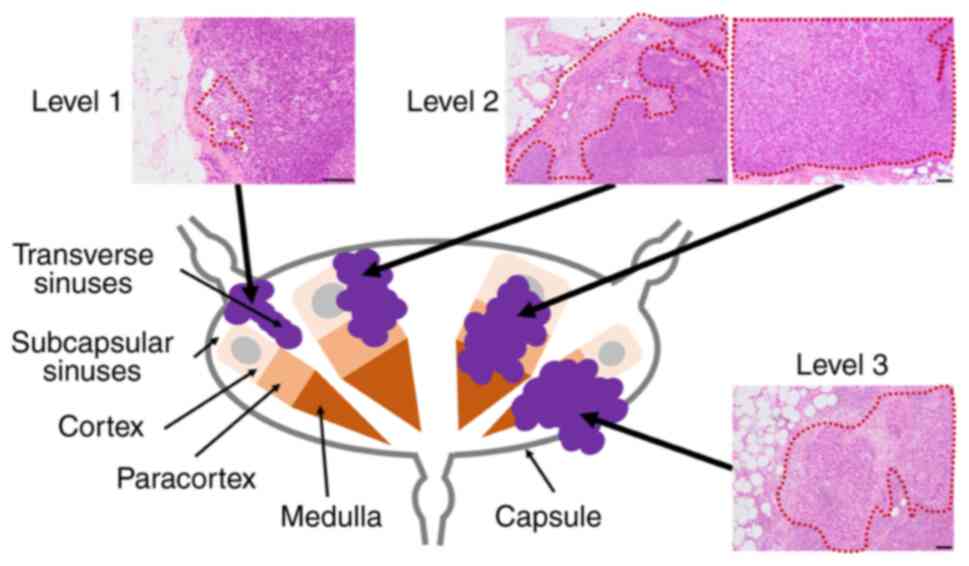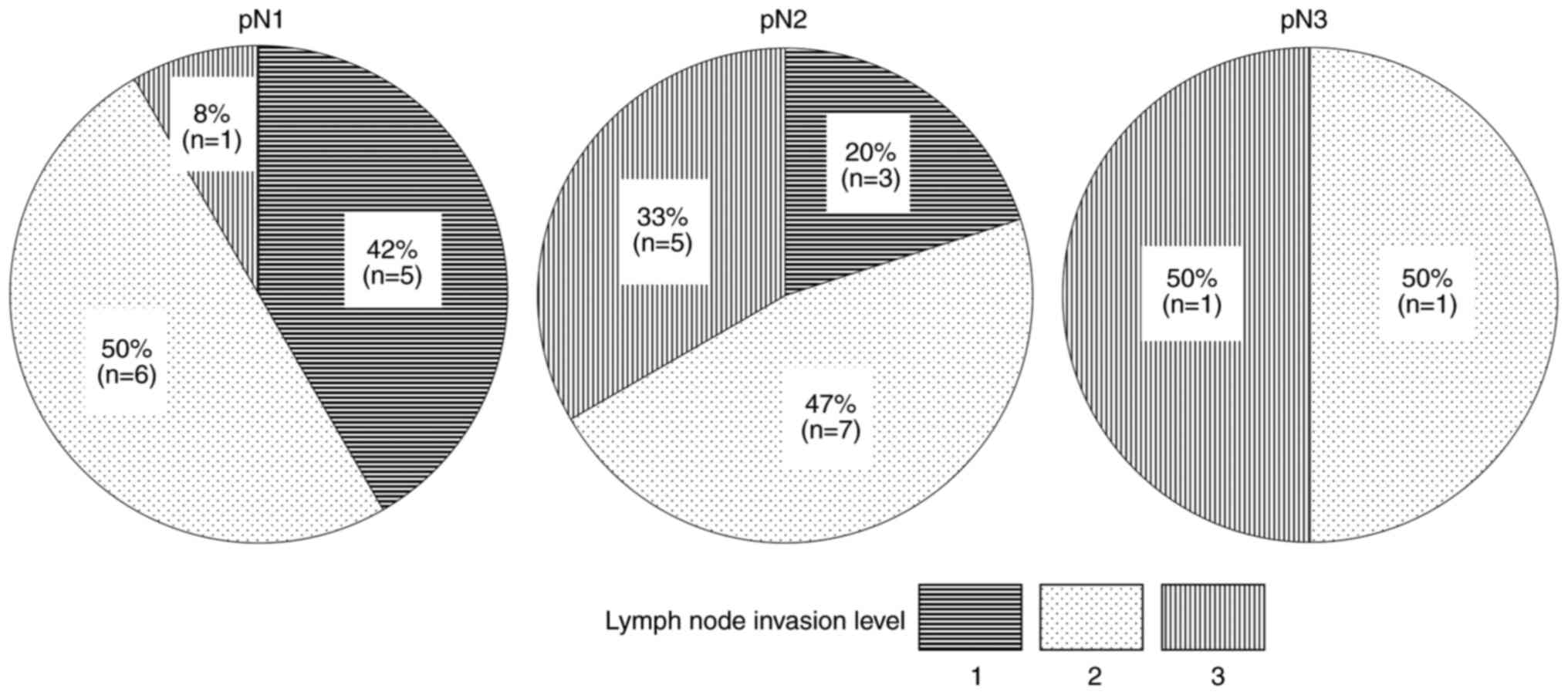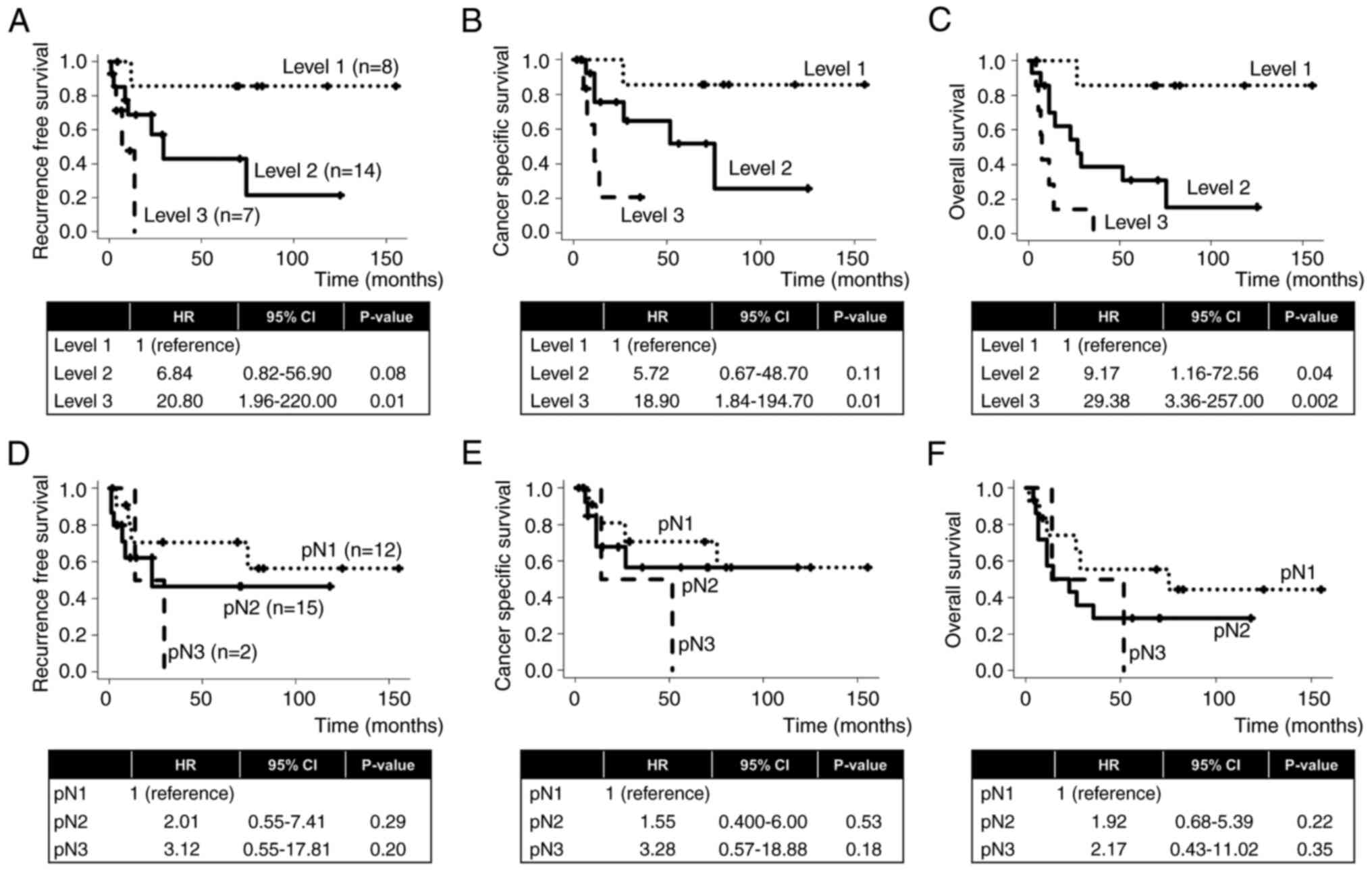|
1
|
Margulis V, Lotan Y, Montorsi F and
Shariat SF: Predicting survival after radical cystectomy for
bladder cancer. BJU Int. 102:15–22. 2008. View Article : Google Scholar : PubMed/NCBI
|
|
2
|
Karl A, Carroll PR, Gschwend JE, Knüchel
R, Montorsi F, Stief CG and Studer UE: The impact of
lymphadenectomy and lymph node metastasis on the outcomes of
radical cystectomy for bladder cancer. Eur Urol. 55:826–835. 2009.
View Article : Google Scholar : PubMed/NCBI
|
|
3
|
Brierley JD: TNM classification of
malignant tumours. 8th edition. Union for International Cancer
Control; 2017
|
|
4
|
Stein JP, Cai J, Groshen S and Skinner DG:
Risk factors for patients with pelvic lymph node metastases
following radical cystectomy with en bloc pelvic lymphadenectomy:
Concept of lymph node density. J Urol. 170:35–41. 2003. View Article : Google Scholar : PubMed/NCBI
|
|
5
|
May M, Herrmann E, Bolenz C, Tiemann A,
Brookman-May S, Fritsche HM, Burger M, Buchner A, Gratzke C,
Wülfing C, et al: Lymph node density affects cancer-specific
survival in patients with lymph node-positive urothelial bladder
cancer following radical cystectomy. Eur Urol. 59:712–718. 2011.
View Article : Google Scholar : PubMed/NCBI
|
|
6
|
Stephenson AJ, Gong MC, Campbell SC,
Fergany AF and Hansel DE: Aggregate lymph node metastasis diameter
and survival after radical cystectomy for invasive bladder cancer.
Urology. 75:382–386. 2010. View Article : Google Scholar : PubMed/NCBI
|
|
7
|
Fajkovic H, Cha EK, Jeldres C, Robinson
BD, Rink M, Xylinas E, Chromecki TF, Breinl E, Svatek RS, Donner G,
et al: Extranodal extension is a powerful prognostic factor in
bladder cancer patients with lymph node metastasis. Eur Urol.
64:837–845. 2013. View Article : Google Scholar : PubMed/NCBI
|
|
8
|
Masson-Lecomte A, Vordos D, Hoznek A, Yiou
R, Allory Y, Abbou CC, de la Taille A and Salomon L: External
validation of extranodal extension and lymph node density as
predictors of survival in node-positive bladder cancer after
radical cystectomy. Ann Surg Oncol. 20:1389–1394. 2013. View Article : Google Scholar : PubMed/NCBI
|
|
9
|
Fleischmann A, Thalmann GN, Markwalder R
and Studer UE: Extracapsular extension of pelvic lymph node
metastases from urothelial carcinoma of the bladder is an
independent prognostic factor. J Clin Oncol. 23:2358–2365. 2005.
View Article : Google Scholar : PubMed/NCBI
|
|
10
|
Compérat E, Srigley JR, Brimo F, Delahunt
B, Koch M, Lopez-Beltran A, Reuter V, Samaratunga H, Shanks JH,
Tsuzuki T, et al: Dataset for the reporting of carcinoma of the
bladder-cystectomy, cystoprostatectomy and diverticulectomy
specimens: Recommendations from the International Collaboration on
Cancer Reporting (ICCR). Virchows Arch. 476:521–534. 2020.
View Article : Google Scholar : PubMed/NCBI
|
|
11
|
Kretschmer L, Mitteldorf C, Hellriegel S,
Leha A, Fichtner A, Ströbel P, Schön MP and Bremmer F: The sentinel
node invasion level (SNIL) as a prognostic parameter in melanoma.
Mod Pathol. 34:1839–1849. 2021. View Article : Google Scholar : PubMed/NCBI
|
|
12
|
van der Ploeg AP, van Akkooi AC, Schmitz
PI, Koljenovic S, Verhoef C and Eggermont AM: EORTC Melanoma Group
sentinel node protocol identifies high rate of submicrometastases
according to Rotterdam Criteria. Eur J Cancer. 46:2414–2421. 2010.
View Article : Google Scholar : PubMed/NCBI
|
|
13
|
Moch H, Humphrey PA, Ulbright TM and
Reuter VE: WHO classification of tumours of the urinary system and
male genital organs. International Agency for Research on Cancer;
Lyon: 2016
|
|
14
|
Ikeda J, Ohe C, Yoshida T, Kuroda N, Saito
R, Kinoshita H, Tsuta K and Matsuda T: Comprehensive pathological
assessment of histological subtypes, molecular subtypes based on
immunohistochemistry, and tumor-associated immune cell status in
muscle-invasive bladder cancer. Pathol Int. 71:173–182. 2021.
View Article : Google Scholar : PubMed/NCBI
|
|
15
|
Haley P, Perry R, Ennulat D, Frame S,
Johnson C, Lapointe JM, Nyska A, Snyder P, Walker D and Walter G;
STP Immunotoxicology Working Group, : STP position paper: Best
practice guideline for the routine pathology evaluation of the
immune system. Toxicol Pathol. 33:404–407; discussion 408. 2005.
View Article : Google Scholar : PubMed/NCBI
|
|
16
|
Kanda Y: Investigation of the freely
available easy-to-use software ‘EZR’ for medical statistics. Bone
Marrow Transplant. 48:452–458. 2013. View Article : Google Scholar : PubMed/NCBI
|
|
17
|
Russo P, Palermo G, Iacovelli R, Ragonese
M, Ciccarese C, Maioriello G, Fantasia F, Bizzarri FP, Marino F,
Moosavi K, et al: Comparison of PIV and other immune inflammation
markers of oncological and survival outcomes in patients undergoing
radical cystectomy. Cancers (Basel). 16:6512024. View Article : Google Scholar : PubMed/NCBI
|
|
18
|
Willard-Mack CL: Normal structure,
function, and histology of lymph nodes. Toxicol Pathol. 34:409–424.
2006. View Article : Google Scholar : PubMed/NCBI
|
|
19
|
Nathanson SD: Insights into the mechanisms
of lymph node metastasis. Cancer. 98:413–423. 2003. View Article : Google Scholar : PubMed/NCBI
|
|
20
|
Margaris KN and Black RA: Modelling the
lymphatic system: Challenges and opportunities. J R Soc Interface.
9:601–612. 2012. View Article : Google Scholar : PubMed/NCBI
|
|
21
|
Bazigou E, Wilson JT and Moore JE Jr:
Primary and secondary lymphatic valve development: Molecular,
functional and mechanical insights. Microvasc Res. 96:38–45. 2014.
View Article : Google Scholar : PubMed/NCBI
|
|
22
|
Liao YA, Chiang CJ, Lee WC, Zhuang BZ,
Chen CH and Pu YS: Extranodal extension predicts poor survival
outcomes among patients with bladder cancer. Cancers (Basel).
13:41082021. View Article : Google Scholar : PubMed/NCBI
|
|
23
|
Kurahashi T, Hara I, Oka N, Kamidono S,
Eto H and Miyake H: Detection of micrometastases in pelvic lymph
nodes in patients undergoing radical cystectomy for locally
invasive bladder cancer by real-time reverse transcriptase-PCR for
cytokeratin 19 and uroplakin II. Clin Cancer Res. 11:3773–3777.
2005. View Article : Google Scholar : PubMed/NCBI
|
|
24
|
Matsumoto R, Takada N, Abe T, Minami K,
Harabayashi T, Nagamori S, Hatanaka KC, Miyajima N, Tsuchiya K,
Maruyama S, et al: Prospective mapping of lymph node metastasis in
Japanese patients undergoing radical cystectomy for bladder cancer:
Characteristics of micrometastasis. Jpn J Clin Oncol. 45:874–880.
2015. View Article : Google Scholar : PubMed/NCBI
|
|
25
|
Jensen JB, Høyer S and Jensen KM:
Incidence of occult lymph-node metastasis missed by standard
pathological examination in patients with bladder cancer undergoing
radical cystectomy. Scand J Urol Nephrol. 45:419–424. 2011.
View Article : Google Scholar : PubMed/NCBI
|
|
26
|
Weingärtner K, Ramaswamy A, Bittinger A,
Gerharz EW, Vöge D and Riedmiller H: Anatomical basis for pelvic
lymphadenectomy in prostate cancer: Results of an autopsy study and
implications for the clinic. J Urol. 156:1969–1971. 1996.
View Article : Google Scholar : PubMed/NCBI
|
|
27
|
Fu W and Zhang X: Laparoscopic and
robotic-assisted extended pelvic lymph node dissection for invasive
bladder cancer: A review. Bladder (San Franc).
10:e212000042023.PubMed/NCBI
|
|
28
|
Del Bene G, Calabrò F, Giannarelli D,
Plimack ER, Harshman LC, Yu EY, Crabb SJ, Pal SK, Alva AS, Powles
T, et al: Neoadjuvant vs. adjuvant chemotherapy in muscle invasive
bladder cancer (MIBC): Analysis from the RISC database. Front
Oncol. 8:4632018. View Article : Google Scholar : PubMed/NCBI
|
|
29
|
Loverro M, Bizzarri N, Capomacchia FM,
Watrowski R, Querleu D, Gioè A, Naldini A, Santullo F, Foschi N,
Fagotti A, et al: Indocyanine green fluorescence applied to
gynecologic oncology: Beyond sentinel lymph node. Int J Surg.
110:3641–3653. 2024.PubMed/NCBI
|













